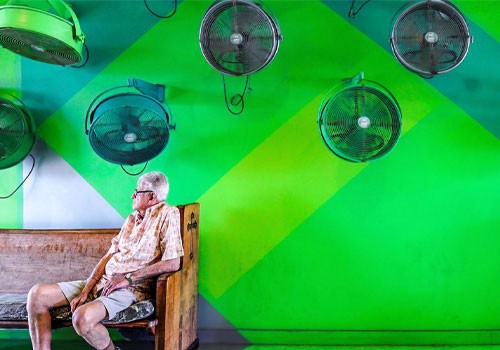SUMMARY
Most people understand the concept of evaporation if only a basic level. The liquid will dry up eventually, and its molecules will return to the air in gas form. However, not all people understand that this method can be the answer to their rising energy costs.
A Phase Change
Anytime a liquid changes into a gas, it absorbs heat. This is technically true for every liquid, but evaporative cooling works best with water. Everyone is familiar with how liquid cools us down, even if they would not call it by its scientific name of “latent heat of evaporation or vaporization”. Every time we sweat, the body is attempting to bring the skin’s external temperature to stave off symptoms of overheating.
As the sweat covers our bodies, it begins to evaporate. As the vapor leaves the top layer of the skin, the gas form of the sweat takes the heat with it. The heat transfer rate is highly dependent on the temperature and the humidity that is already in the air. The evaporation rate in a humid climate will be slower, which is why people tend to feel warmer when the humidity is higher.
The Wonders of Water
Water can do more than cool down the skin. It has one of the lowest rates of evaporation, which means it takes a lot of heat from the air as it goes through the transformation process. It is why when people travel to the beach, they find the air is typically much cooler near the water. The energy it takes for the top layer of water to evaporate has a massive effect on the surrounding air. The key to effective evaporative cooling is to find a way to increase the rate of evaporation to provide a more effective solution to those who need larger spaces cooled.
Evaporative Cooling on a Larger Scale
As technology improved, people stopped relying solely on sweat to cool down. Central air conditioning is now used in every part of the country to provide relief from the heat, but air conditioning uses up so much energy compared to evaporative cooling. Water is everywhere, it is completely safe, and it will evaporate in practically every setting.
Conventional evaporative coolers can take the 95° air from outside and convert it to 75° air. One of the reasons they are not used as often is because they work best in arid climates, and they need a constant supply of water to perform efficiently. However, those who are committed to the environment have been hard at work to adapt evaporative cooling for every type of climate. These coolers can save both residential and commercial building owners 80% or more on cooling costs, and they keep the indoor environment free from the dry air that can affect the skin and eyes.
The Benefits of Evaporative Cooling
No decision maker has time to take a science class to fully understand how evaporative cooling works, but that should not stop everyone from exploring new ways to keep their business more profitable. When you are responsible for keeping everyone cool, remember the following about evaporative cooling:
- Lower energy use than traditional A/C
- Air feels fresher indoors
- Easy installation and setup
- Germs and airborne pollutants are reduced
- Eyes and skin are irritant-free (even after prolonged exposure)
Without understanding more about the science behind evaporative cooling, it will be difficult to trust this solution as a valid option for a building. By exploring the topic though, smart owners may find the answer to many of the questions they’ve had about picking the most cost-effective cooling methods for their project.
If Evaporative Cooling Isn’t For You
But maybe evaporative cooling isn’t for you. Perhaps you live in an area with high humidity or rely on A/C to quickly condition a room. In that case, Airius units might be a good in-between solution. They serve many of the same purposes of evaporative coolers, like using airflow to cool, rather than phased heat exchange, and they cost even less to operate. If an array of Airius destratification fans sounds like a better solution for you than additional A/C units or an evaporative cooling solution, give Sales a call at 800-AIR-PEAR or Contact Us.




Leave A Comment
You must be logged in to post a comment.